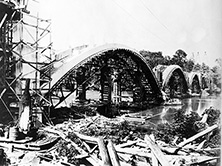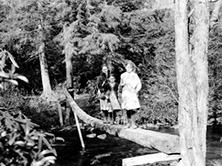 Construction of reinforced concrete Swift Island Ferry Bridge (Stanley County Bridge 51) over the Pee Dee River, ca.1925 (courtesy of The State Archives of North Carolina).
Construction of reinforced concrete Swift Island Ferry Bridge (Stanley County Bridge 51) over the Pee Dee River, ca.1925 (courtesy of The State Archives of North Carolina). Historic bridges tell us about the people who built them, what materials were available at the time, and how they thought about shaping and joining together those materials. As such, a bridge is a direct reflection of the knowledge and skills of its engineer or builder, and of the society and culture that sponsored its construction.
The evolution of bridge technology in America begins with colonial carpenters and masons building mostly short-span bridges of timber or stone with traditional methods. From about 1800 to 1860, the growth in overland trade and the introduction of turnpikes, canals and railroads prompted experimentation and investment in longer bridges to span America's wide rivers. This led first to the development of wood truss bridges, often covered with siding and a roof to protect the load-carrying trusses, and then to the use of iron for greater strength and capacity. Along with these new bridge types came a rapid growth in engineering knowledge and the establishment of the first college programs to train professional engineers.
 Children on log footbridge in unidentified North Carolina National Forest, ca.1890s (Gifford Pinchot) (D.H. Ramsey Library Special Collections, UNC-Asheville) The second half of the 19th century saw major growth in the bridge industry with hundreds of companies marketing prefabricated truss bridges of iron or steel. These bridges, often sold by catalogue, were manufactured in factories and shipped to the site for final assembly. They reflected an amazing diversity and ingenuity of engineering, and a distinctly American approach to bridge building.
Children on log footbridge in unidentified North Carolina National Forest, ca.1890s (Gifford Pinchot) (D.H. Ramsey Library Special Collections, UNC-Asheville) The second half of the 19th century saw major growth in the bridge industry with hundreds of companies marketing prefabricated truss bridges of iron or steel. These bridges, often sold by catalogue, were manufactured in factories and shipped to the site for final assembly. They reflected an amazing diversity and ingenuity of engineering, and a distinctly American approach to bridge building.
During the first half of the 20th century, the automobile and truck brought about the need for highways and bridges better suited to safe, high-speed, motorized travel. The bridge-building materials of choice were reinforced concrete and steel for economy, permanency and strength. The federal and state governments established highway agencies with engineers who promoted the use of standardized bridge designs in the development of state highway systems.
Most of North Carolina's historic highway bridges date from the late 1910s through the 1950s, an era of federal- and state-sponsored improvements that continues to the present.